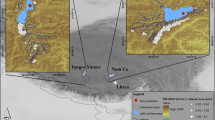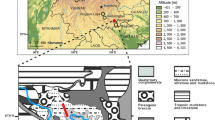Abstract
Glacier-fed lakes on the Tibetan Plateau (TP) have undergone rapid expansions since the late 1990s, concurrent with the changing climate. However, the dominant cause(s) of lake area increases is still debated. To identify the drivers of lake expansion, we studied Aweng Co, a glacier-fed lake in the western TP, where surface area has increased (0.74 km2 year−1) since the late 1970s and most rapidly (0.998 km2 year−1) since the late 1990s. A water balance model was used to clarify the reasons for increased lake water volume, supported by stable isotope hydrology and the δ18O change recorded in recent sediments. Results showed that glacial meltwater probably had the biggest impact on changes in Aweng Co lake level in recent decades, but that precipitation was also an important contributor. Our study shows that δ18O of carbonate (δ18Ocarb) has great potential for indicating source changes of water supply in such lakes, but there is a need to be cautious when interpreting δ18Ocarb due to the influence of multiple hydrological factors, which can change in dominance over time.




Similar content being viewed by others
References
Appleby PG, Oldfield F (1978) The calculation of lead-210 dates assuming a constant rate of supply of unsupported 210Pb to the sediment. CATENA 5:1–8
Atkinson SE, Woods RA, Sivapalan M (2002) Climate and landscape controls on water balance model complexity over changing timescales. Water Resour Res 38:50-1–50-15
Chen J, Zhu X, Vogelmann JE, Gao F, Jin S (2011) A simple and effective method for filling gaps in Landsat ETM + SLC-off images. Remote Sens Environ 115:1053–1064
Conway D (1997) A water balance model of the Upper Blue Nile in Ethiopia. Hydrol Sci J 42:165–286
Craig H (1965) The measurement of oxygen isotope palaeotemperatures. In: Tongiorgi E (ed) Stable isotopes in oceanographic studies and palaeotemperatures. Consiglio Nazionale delle Ricerche Laboratorio di Geologia Nucleare, Pisa, pp 161–182
Craig H, Gordon LI (1965) Deuterium and oxygen-18 variation in the ocean and marine atmosphere. In: Tongiorgi E (ed) Stable isotopes in oceanography studies and paleotemperatures. Consiglio Nazionale delle Ricerche Laboratorio di Geologia Nucleare, Pisa, pp 9–130
Crétaux JF, Abarca-del-Río R, Bergé-Nguyen M, Arsen A, Drolon V, Clos G, Maisongrande P (2016) Lake volume monitoring from space. Surv Geophys 37:269–305
Gibson J (2002) A new conceptual model for predicting isotopic enrichment of lakes in seasonal climates. Pages News 10:10–11
Gibson JJ, Birks SJ, Yi Y (2016) Stable isotope mass balance of lakes: a contemporary perspective. Quat Sci Rev 131:316–328
Gleick PH (1987) The development and testing of a water balance model for climate impact assessment: modeling the Sacramento Basin. Water Resour Res 23:1049–1061
Gonfiantini R (1986) Environmental isotopes in lake studies. In: Fritz P, Fontes JC (eds) Handbook of environmental isotope geochemistry, vol 3. Elsevier Scientific Publishing Company, Amsterdam, pp 113–168
Guo S, Wang J, Xiong L, Ying A, Li D (2002) A macro-scale and semi-distributed monthly water balance model to predict climate change impacts in China. J Hydrol 268:1–15
Guo X, Tian L, Wen R, Yu W, Qu D (2017) Controls of precipitation δ18O on the northwestern Tibetan Plateau: a case study at Ngari station. Atmos Res 189:141–151
Huss M (2013) Density assumptions for converting geodetic glacier volume change to mass change. The Cryosphere 7(3):877–887
Jones MD, Roberts CN, Leng MJ (2007) Quantifying climatic change through the last glacial-interglacial transition based on lake isotope palaeohydrology from central Turkey. Quat Res 67:463–473
Jones MD, Cuthbert MO, Leng MJ, McGowan S, Mariethoz G, Arrowsmith C, Sloane HJ, Humphrey KK, Cross I (2016) Comparisons of observed and modelled lake δ18O variability. Quat Sci Rev 131:329–340
Lacey JH, Jones MD (2018) Quantitative reconstruction of early Holocene and last glacial climate on the Balkan Peninsula using coupled hydrological and isotope mass balance modelling. Quat Sci Rev 202:109–121
Lei Y, Yao T, Bird BW, Yang K, Zhai J, Sheng Y (2013) Coherent lake growth on the central Tibetan Plateau since the 1970s: characterization and attribution. J Hydrol 483:61–67
Lei Y, Yang K, Wang B, Sheng Y, Bird BW, Zhang G, Tian L (2014) Response of inland lake dynamics over the Tibetan Plateau to climate change. Clim Change 125:281–290
Lei Y, Yao T, Yang K, Sheng Y, Kleinherenbrink M, Yi S, Bird BW, Zhang X, Zhu L, Zhang G (2017) Lake seasonality across the Tibetan Plateau and their varying relationship with regional mass changes and local hydrology. Geophys Res Lett 44:892–900
Leng MJ, Marshall JD (2004) Palaeoclimate interpretation of stable isotope data from lake sediment archives. Quat Sci Rev 23:811–831
Li X, Wang M, Zhang Y, Lei L, Hou J (2017) Holocene climatic and environmental change on the western Tibetan Plateau revealed by glycerol dialkyl glycerol tetraethers and leaf wax deuterium-to-hydrogen ratios at Aweng Co. Quat Res 87:455–467
Linacre E (1992) Climate data and resources: a reference and guide. Routledge, London, p 366
Magny M (2004) Holocene climate variability as reflected by mid-European lake-level fluctuations and its probable impact on prehistoric human settlements. Quat Int 113:65–79
Majoube F (1971) Fractionnement en oxygene-18 et en deuterium entre l'eau et sa vapeur. J Chem Phys 68:1423–1436
Neckel N, Kropáček J, Bolch T, Hochschild V (2014) Glacier mass changes on the Tibetan Plateau 2003–2009 derived from ICESat laser altimetry measurements. Environ Res Lett 9:1–7
Phan VH, Lindenbergh R, Menenti M (2012) ICESat derived elevation changes of Tibetan lakes between 2003 and 2009. Int J Appl Earth Obs Geoinf 17:12–22
Qiang M, Song L, Chen F, Li M, Liu X, Wang Q (2013) A 16-ka lake-level record inferred from macrofossils in a sediment core from Genggahai Lake, northeastern Qinghai-Tibetan Plateau (China). J Paleolimnol 49:575–590
Rouse WR (1998) A water balance model for subarctic sedge fen and its application to climatic change. Clim Change 38:207–234
Rowe HD, Guilderson TP, Dunbar RB, Southon JR, Seltzer GO, Mucciarone DA, Fritz SC, Baker PA (2003) Late Quaternary lake-level changes constrained by radiocarbon and stable isotope studies on sediment cores from Lake Titicaca, South America. Glob Planet Change 38:273–290
Song C, Huang B, Ke L (2013) Modeling and analysis of lake water storage changes on the Tibetan Plateau using multi-mission satellite data. Remote Sens Environ 135:25–35
Song C, Huang B, Richards K, Ke L, Phan VH (2014) Accelerated lake expansion on the Tibetan Plateau in the 2000s: Induced by glacial melting or other processes? Water Resour Res 50:3170–3186
Steinman BA, Rosenmeier MF, Abbott MB (2010a) The isotopic and hydrologic response of small, closed-basin lakes to climate forcing from predictive models: simulations of stochastic and mean-state precipitation variations. Limnol Oceanogr 55:2246–2261
Steinman BA, Rosenmeier MF, Abbott MB, Bain DJ (2010b) The isotopic and hydrologic response of small, closed-basin lakes to climate forcing from predictive models: application to paleoclimate studies in the upper Columbia River basin. Limnol Oceanogr 55:2231–2245
Thompson LG, Mosley-Thompson E, Davis ME, Brecher HH (2011) Tropical glaciers, recorders and indicators of climate change, are disappearing globally. Ann Glaciol 52:23–34
Thompson LG, Yao T, Davis ME, Mosley-Thompson E, Wu G, Porter SE, Xu B, Lin PN, Wang N, Beauson E, Duan K, Sierra-Hernandez MR, Kenny DV (2018) Ice core records of climate variability on the Third Pole with emphasis on the Guliya ice cap, western Kunlun Mountains. Quat Sci Rev 188:1–14
Wang S, Dou H (1998) Records of lakes in China (in Chinese). Science Press, Beijing
Wu X, Huang W, Chen F (2014) Construction and application of monthly air temperature and precipitation gridded datasets with high resolution (0.025*0.025) over China during 1951–2012 (in Chinese). J Lanzhou Univ 50:213–220
Xu H, Ai L, Tan L, An Z (2006) Stable isotopes in bulk carbonates and organic matter in recent sediments of Lake Qinghai and their climatic implications. Chem Geol 235:262–275
Xu H, Goldsmith Y, Lan J, Tan L, Wang X, Zhou X, Cheng J, Lang Y, Liu C (2020) Juxtaposition of western Pacific subtropical high on Asian summer monsoon shapes subtropical East Asian precipitation. Geophys Res Lett 47:1–10
Yang M, Nelson FE, Shiklomanov NI, Guo D, Wan G (2010) Permafrost degradation and its environmental effects on the Tibetan Plateau: a review of recent research. Earth Sci Rev 103:31–44
Yang K, Wu H, Qin J, Lin C, Tang W, Chen Y (2014) Recent climate changes over the Tibetan Plateau and their impacts on energy and water cycle: a review. Glob Planet Change 112:79–91
Yao T, Pu J, Lu A, Wang Y, Yu W (2007) Recent glacial retreat and its impact on hydrological processes on the Tibetan Plateau, China, and surrounding regions. Arctic Antarct Alp Res 39:642–650
Yao T, Thompson L, Yang W, Yu W, Gao Y, Guo X, Yang X, Duan K, Zhao H, Xu B, Pu J, Lu A, Xiang Y, Kattel DB, Joswiak D (2012) Different glacier status with atmospheric circulations in Tibetan Plateau and surroundings. Nat Clim Change 2:663–667
Yuan F, Sheng Y, Yao T, Fan C, Li J, Zhao H, Lei Y (2011) Evaporative enrichment of oxygen-18 and deuterium in lake waters on the Tibetan Plateau. J Paleolimnol 46:291–307
Zhang G (2019) The lakes larger than 1 km2 in Tibetan Plateau (V2.0) (1970s-2018). Natl Tibet Plateau Data Cent
Zhang G, Xie H, Kang S, Yi D, Ackley SF (2011) Monitoring lake level changes on the Tibetan Plateau using ICESat altimetry data (2003–2009). Remote Sens Environ 115:1733–1742
Zhang G, Yao T, Xie H, Zhang K, Zhu F (2014) Lakes’ state and abundance across the Tibetan Plateau. Chin Sci Bull 59:3010–3021
Zhang G, Yao T, Xie H, Wang W, Yang W (2015) An inventory of glacial lakes in the Third Pole region and their changes in response to global warming. Glob Planet Change 131:148–157
Zhang G, Yao T, Piao S, Bolch T, Xie H, Chen D, Gao Y, O’Reilly CM, Shum CK, Yang K, Yi S, Lei Y, Wang W, He Y, Shang K, Yang X, Zhang H (2017a) Extensive and drastically different alpine lake changes on Asia’s high plateaus during the past four decades. Geophys Res Lett 44:252–260
Zhang G, Li J, Zheng G (2017b) Lake-area mapping in the Tibetan Plateau: an evaluation of data and methods. Int J Remote Sens 38:742–772
Zhang G, Luo W, Chen W, Zheng G (2019a) A robust but variable lake expansion on the Tibetan Plateau. Sci Bull 64:1306–1309
Zhang Y, Li Y, Zhu G (2019b) The effect of altitude on temperature, precipitation and climatic zone in the Qinghai-Tibetan (in Chinese). J Glaciol Geocryol 41:505–515
Zhu L, Xie M, Wu Y (2010) Quantitative analysis of lake area variations and the influence factors from 1971 to 2004 in the Nam Co basin of the Tibetan Plateau. Chi Sci Bull 55:1294–1303
Acknowledgements
This study is supported by the National Natural Science Foundation of China (NSFC 41771212) and Fundamental Research Fund for the Central Universities (lzujbky-2017-it81). We would like to thank Juzhi Hou, Mingda Wang, Yaping Yang and Erlei Zhu for assisting the field work. We also thank Melanie Leng for her constructive suggestions in improving the quality of the manuscript, and Xian Wu for providing the interpolated meteorological data in the catchment. We thank Thomas J. Whitmore, Steffen Mischke and two anonymous reviewers for detailed comments which improved the manuscript. The authors have no conflict of interest to declare.
Author information
Authors and Affiliations
Corresponding author
Additional information
Publisher's Note
Springer Nature remains neutral with regard to jurisdictional claims in published maps and institutional affiliations.
Electronic supplementary material
Below is the link to the electronic supplementary material.
Rights and permissions
About this article
Cite this article
Zhang, Y., Jones, M., Zhang, J. et al. Can δ18O help indicate the causes of recent lake area expansion on the western Tibetan Plateau? A case study from Aweng Co. J Paleolimnol 65, 169–180 (2021). https://doi.org/10.1007/s10933-020-00158-6
Received:
Accepted:
Published:
Issue Date:
DOI: https://doi.org/10.1007/s10933-020-00158-6




